
For folks who handload or shoot competitively, a chronograph is a standard piece of equipment. There are costly and very precise multi purpose pieces of equipment, like Oehler industrial systems and there are high end dedicated chronographs like the Kurzzeit PVN-08. Accuracy and reliability of readings is a given, so most of the value that justifies the cost of these systems is related to environmental flexibility in use or elaborate data collection and analysis software. The Oehler systems are $10,000+. The PVN-08 is priced just below $750.
The low and mid range of consumer chronographs, $100 – $250, are produced by companies like Chrony, Competition Electronics, Pact, and RSI. While software function may not be lab-worthy in the area of data collection and analysis, they all collect and display more data than most shooters and handloaders can use and the units are more than sufficiently accurate.
There are a couple of drawback to lower priced systems. To overcome a need for bright sunlight for reliable operation, manufacturers have been incorporating sensors matched to infrared or LED light sources integrated into the units. Unfortunately, these systems often require a 120v power source, or a battery pack, which diminishes system portability. Additionally, these types of systems require screens to be placed ahead of a shooting bench, which can make for quite a workout while trying to set up at a busy public range. The MagnetoSpeed barrel mounted chronograph utilized a different technology to potentially overcome all of these noted light source chronograph deficiencies.
Magnetic Personality
All chronographs have at least two points of sensing the presence of a bullet. The first starts a timer, the second stops the timer. A circuit that polls the outputs from the two sensors, clocks the time it takes for the bullet to travel from the first sensor to the second and interprets this interval into feet per second for display. Whereas light-based sensors have to detect the movement of a bullet by seeing the projectile in contrast to light above the bullet, the MagnetoSpeed’s sensors are triggered when a bullet disturbs electromagnetic fields. These sensors do not react to powder residue, nor do they require, nor are they influenced by, ambient light. Because the electromagnetic sensors are effected by ambient light or ejecta mass, only the bullet passing over them, there is no need to position the MagnetoSpeed’s sensors a distance from a gun’s muzzle. The MagnetoSpeed sensor assembly is mounted directly to the gun’s barrel.
In contrast to a conventional consumer chronograph, the MagnetoSpeed technology does not require daylight or a source of artificial light, it requires no 110 volt power source of high capacity battery pack that would diminish its portability and it requires no tripod mounted equipment to be placed downrange from the firearm being tested. The unit, complete with display, is small enough to pack into a shooting box or backpack and it weights next to nothing.
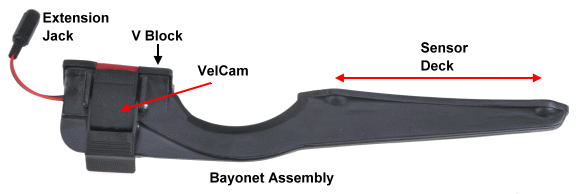
The four ounce bayonet assembly replaces the sky screens used by traditional chronographs. The bayonet secures to a rifle’s muzzle at the V Block and is secured by the Velcam, which is essentially a Velcro strap and fiber filled plastic strap clasp. The bayonet is comprised of an aluminum blade that runs the length of the assembly and two sensors, all held in place with a molded plastic exterior. The extension jack connects the unit to a remote display. The unit I received was pre-production so it was not as slick as production pieces might be, but it was easy to see how nice the production pieces will look and the unit worked as described by the company. The Velcam is a nifty name, but the assembly needs work to be made more durable in operation and this work was already underway.
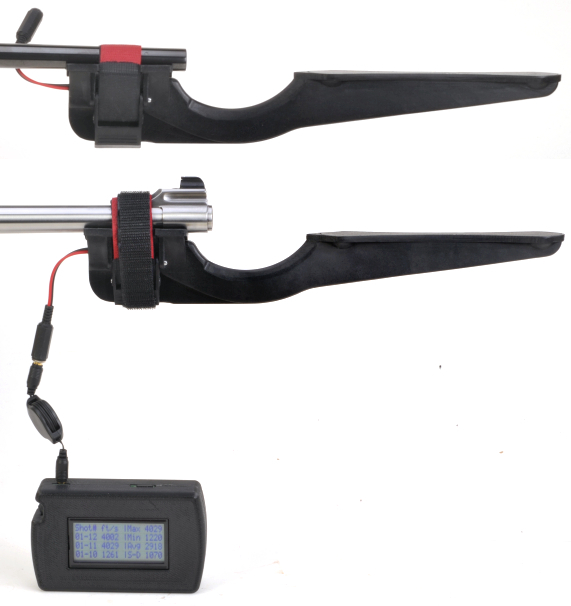
The MagnetoSpeed was installed on three rifles, a Winchester Model 70 Compact, top, a Ruger No.1 Tropical, below, and a Model 700 heavy barrel target rifle, not shown. The V Block and Velcam handled all three without a problem, leaving the suggested half inch of muzzle ahead of the V Block. MagnetoSpeed specifies the unit can be mounted on any tapered or bull barrel muzzle diameter from 0.550″ to 1.000″. In this instance the Winchester muzzle was 0.580″ and the Remington measured 1.000″. There was no problem strapping the bayonet over the ramped front sight of the Ruger, or in lining up over the sight’s barrel band. The display is close to the bayonet only for the sake of the picture. The jacks are reel mounted and can be extended to a length of 32″ which places the display away from a gun’s muzzle and close to the shooter.
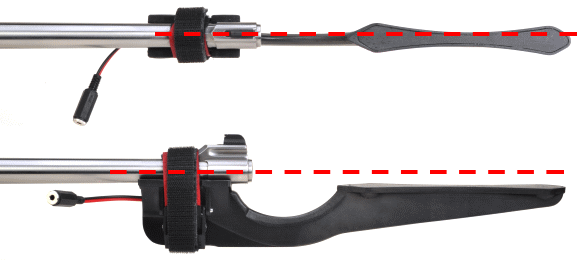
Just like any other chronograph, whatever triggers as the bullet passes through, must be in alignment with the bore along two axes; longitudinal and vertical. In changing alignment to a small degree, no real difference was noted in readings and eyeballing is good enough, just as it is when sighting a rifle. In use, the small diameter and tapered Winchester barrel required a little shimming at the front of the V Block to move the front sensor out of the bullet path. The others required no such attention. The top illustration is about maximum front sensor misalignment. Moving much further results in an “Error 2” display message just like when you misalign a rear sky screen on a conventional chronograph, however, the condition can easily be corrected with the MagnetoSpeed. All of this information, cautions and instruction are covered in the product’s manual, so this isn’t exactly breaking news.
Personally, I’d like to see some simple method of adjustment or offset built into the unit to make keeping the unit in proper alignment a routine and consistent task. Actually, I’d pack it with a stub laser for the bore and a flip up target at the end of the bayonet for alignment and, of course, double the cost and price of the product. Never mind. A simple mechanical adjuster would do just fine.
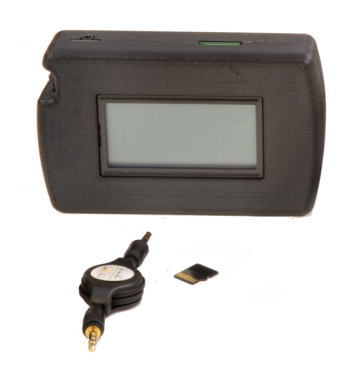
Tidy, but again, a preproduction enclosed LCD display. 2.75″H x 4.50″W x 1.25″D enclosure with a 2.75″ diagonally measure display. Four ounces in weight, good contrast and with switchable backlit function. The display is powered by four AAA batteries. As noted earlier, the reel mounted jacks are 4.50″ retracted and 32″ extended.
The small microSD card that fits into a slot at the top of the display, records and stores collected data. A miniSD card adapter is also packaged with the unit. Popping the card into a PC reader, a log.csv file opens into an Excel spread sheet in nicely formatted columns and rows for analysis and storage. The same information can be view on the units display, but if you’re like me and have 10 MOA vision, big screen capability is a nice touch.
Once the data is imported into an Excel spread sheet, the columns and rows can be formatted to whatever appearance is appropriate and data can be manipulated and analyzed with progress tracked over an extended period of time.
|
Displaying results
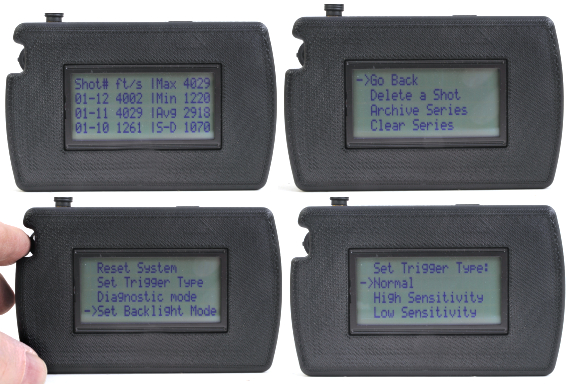
The menu system is easy to navigate with the three-way display switch located on the side of the unit. Up or down pressure controls scrolling, pushing in on the switch selects and option. The top left screen is the default or Home screen, what a shooter sees when firing shots. Depressing the display switch moves to the second level of menus, pressing again, moves to the third and final level of menus. So rather than clutter the unit with a lot of analog switches that can break or be contaminated in use, the product is software controlled with a single switch. Units of measure can be selected, the display can be backlit, data can be selected for archive or recalled for review, trigger sensitivity can be selected and there is a diagnostic screen to help trouble shoot operation. Functions are covered in the instructions packaged with the display.
The MagnetoSpeed in operation…
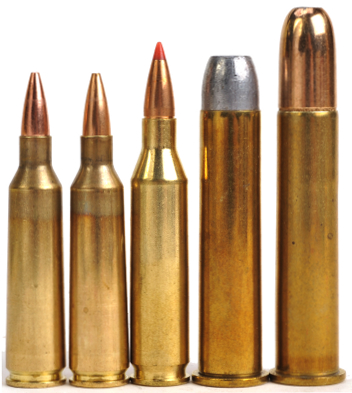
MagnetoSpeed specifically states that copper jacked bullets are optimal for operation, solid lead bullets will not consistently read and bullets with steel content will read erratically. I tried them all, but please keep this in mind when reading the results. These folks are not claiming the unit will work with lead alloy and steel jacketed bullets.
Right – The first two cartridges are 22.250 Remington rounds; solid copper and lead core jacketed. The third is a Hornady Superformance 243 Winchester factory load. The forth is a Black Hills cast lead factory load, The fifth is a 45-70 round handloaded for the Ruger No.1 with a 500 grain Hornady DSX bullet; copper over steel jacket over lead core.
I scratched my head a minute over set up, before I realized I could affix the MagnetoSpeed to the test rifle, put a three screen Oehler out in front and collect correlation data from both units with each shot.
| Cartridge | Bullet | Bullet Weight | Type | MS MV | Oehler MV | FPS Delta | % Difference |
| 22-250 Remington | Speer TNT | 50 | Jacked Lead Core | 3735 | 3800 | 65 | 1.7% |
| 22-250 Remington | Barnes Tac-X | 62 | Solid Copper | 3329 | 3375 | 46 | 1.4% |
| 243 Winchester | Hornady GMX | 80 | Copper – Zinc | 3162 | 3203 | 41 | 1.3% |
| 45-70 Gov’t | Black Hills** | 405 | Lead | 1238 | 1244 | 6 | 0.4% |
| 45-70 Gov’t | Hornady** | 500 | Copper-Steel-Lead | 4016 | 1284 | -2732 | – |
|
** Not recommended for use with MagnetoSpeed by manufacturer |
|||||||
I’m not going to arrive at any conclusions that are much more than conjecture. Schedule permitting I would have liked to have compared the MagnetoSpeed to a couple of other chronographs in house and draw those comparisons with some number of shots fired that would provide a more accurate sample. I can say that the difference between the Oehler and the MagnetoSpeed is just that, a difference, not a validated error on the part of either chronograph. With the exception of the steel content bullet, the delta between chronographs is too small to be of consequence.
The appearance of this limited data is that the degree of difference increases disproportionally higher in comparison to velocity increases but, again, this could be the Oehler as easily as it could be the MagnetoSpeed at the root of the difference. I thought the lead bullet readings were the best in comparison and in consistency. I did not try anything at a lower velocity where MagnetoSpeed indicated they encountered some issues.
Observations… of course
Functionally, I don’t think the steel content jacket issue is much to be concerned with as these are not common bullets. It would be great if lead alloy bullets, and hunting handguns, could be accommodated as these are common and they both spend a lot of time at indoor ranges where the MagnetoSpeed’s unique attributes would be beneficial. While MagnetoSpeed does not recommend the use of the chronograph with handguns, it would seem that if a revolver or single shot pistol barrel were long enough to overhang the mounting V Block, the MagnetoSpeed wouldn’t see a difference between it and a rifle. But I don’t know for sure and I did not try such a set up… with the two Ruger Super Redhawks I had on hand that clocked as accurately as the rifles.
It would be nice if sensor alignment adjustments were added. Too many combinations of barrel taper and V Block movement to assure the bayonet will go in place and line right up. Could be mechanical adjusters, could be a package of spacers or shims. Still like the idea of a self centering plastic spud that goes in the bore and is aligned to a flip up target at the end of the bayonet to check for longitudinal and vertical alignment.
I like the MagnetoSpeed. It offers an new twist on a type of product that otherwise hasn’t changed for a very long time and the twist is useful and meaningful. Injection molded cases and refined bayonet shrouding and aluminum parts finishing I’m sure would provide a slick consumer electronics look, as would retail quality display carton packaging. My guess is, if the product is finessed for production, these folks will sell a million units, retire to Fiji, and I’ll still be freezing in Maine evaluating products.

Email Notification